This is our step-by-step guide on how to dehydrate olives. Dehydrating olives is real easy to do. These dehydrated olives add variety and a nice little zing to dehydrated meals. These are very easy to make using olives from a can or jar. When shopping for olives to dehydrate, choose the pitted olives for less work.
You can dehydrate both black and green olives. The difference between green and black olives is nothing more than when they were picked. Green olives are less ripe and are picked earlier in the season. In general, the darker the olive, the riper it was when it was pulled from the tree.
Some of the more popular olives you might find to dehydrate include:
- Manzanilla is the most common green olive that you will often find stuffed. For dehydrating, choose unstuffed or stuffed with something like pimento or jalapeno pepper for the best results.
- Queen olives, another common green olive that is usually stuffed and dehydrates well. Again, choose unstuffed or stuffed with pimento or jalapeno peppers for best results.
- Kalamata is a deep purple color preserved in either red wine vinegar or red wine.
- Black canned olives are probably from California and are usually picked green and then oxidized to turn them black.
There are other types of great-tasting olives. But you likely won’t find them jarred or canned for easy dehydration. At least not in my area.
Olives are small fruits that grow on olive trees. Olives are rich in antioxidants, vitamins, minerals, and other nutrients. Olives also contain high amounts of potassium and magnesium.
So, let’s get started dehydrating some olives.
Table of Contents
- How to Dehydrate Olives
- Step 1. Process for Dehydrating Olives
- Step 2. Preparing the Dehydrator for Dehydrating Olives
- Step 3. Dehydrating Olives
- Step 4. When are the Dehydrated Olives Done
- Step 5. Equalizing and Conditioning of the Dehydrated Olives
- Step 6. Storing the Dehydrated Olives
- Hydration
- Weights, Measures, and Serving Sizes
- Insider Tips
How to Dehydrate Olives
Dehydrated olives are real easy to make, so make a bunch, and you’ll be glad you did. Dried olives mix well with almost everything: beef, tuna, salmon, and chicken. Just be sure to choose olives that are brined and not in oil. Read and compare the food labels.
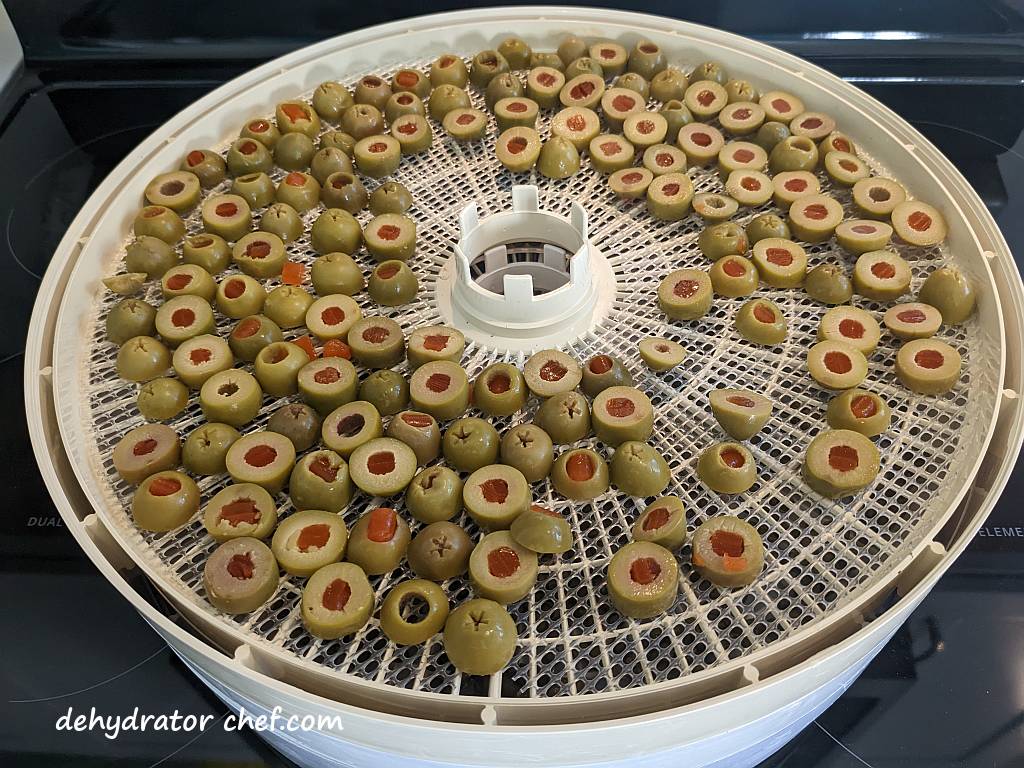
Olives do have naturally occurring fats. The olives I am dehydrating today are 12.5 percent fat per serving. The jar label shows a serving is 2 olives or 16 grams. Each serving has 2 grams of fat. So, doing the math, it’s 12.5 percent. So they will last only a few weeks in the pantry. But you’ll use them up before that once you see how good these are.
Step 1. Process for Dehydrating Olives
First, drain and rinse the olives in water using a strainer or colander. Consider water-soaking your olives for a few hours to remove some of the salt. Dehydrated olives are also fairly salty

Cut whole pitted olives into 3 or 4 rounds. For olives that are already cut in half, just cut them in half again. We want smaller olive pieces for faster dehydration and, for later, faster hydration.
Step 2. Preparing the Dehydrator for Dehydrating Olives
For our dehydrated olives, we are using the Nesco Clean-A-Screen removable mesh screen inserts for sticky fruits and small food items such as these olive slices that we are dehydrating today. They have over 2500 customer reviews with an average rating of 4.7 stars out of 5, which is evidence of a great product. Check out other Nesco food dehydrator products here.

These removable mesh screen inserts have a top and a bottom. The bottom of the screen is smooth. The top of the mesh strands has a pronounced point and feels rough as you rub your fingers across the mesh. If you had a high-powered microscope, you might see the strands in mesh screens are triangle-shaped.
The Nesco 13.5-inch round dehydrator tray has close to 119 square inches or .8 square feet of surface area for drying.
Step 3. Dehydrating Olives
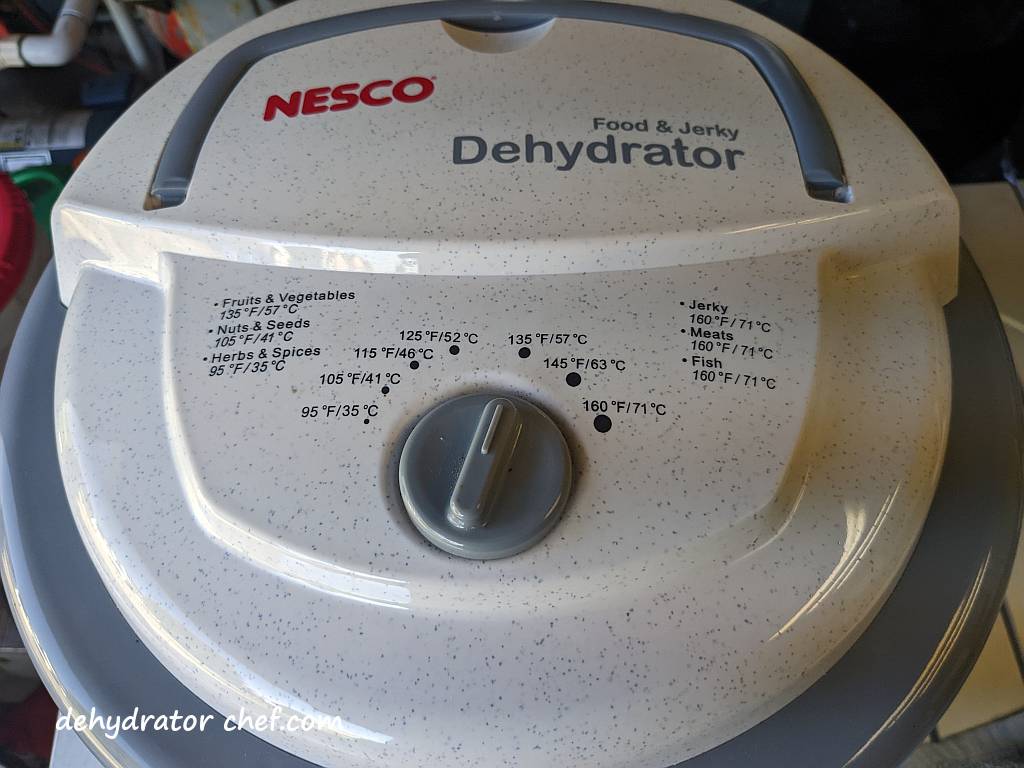
To save time, you can start dehydrating olives by setting the drying temperature to 160 °F / 71 °C for 2 hours. Then dial the temperature back to 135 °F / 57 °C until dry, approximately 6 to 10 hours, depending upon the ambient temperature and humidity and how crowded you fill your trays.
Step 4. When are the Dehydrated Olives Done
Start checking for doneness in 6 to 8 hours. Fully dried olives will feel pliable while warm in the dehydrator. It’s best to remove the tray from the food dehydrator or unplug the dehydrator and let them cool down a bit and then recheck. When dried, the olives should easily snap and break into smaller pieces.

Drying times will vary depending on your dehydrator. Refer to your dehydrator owner’s manual for recommended temperatures and times for dehydrating specific foods.
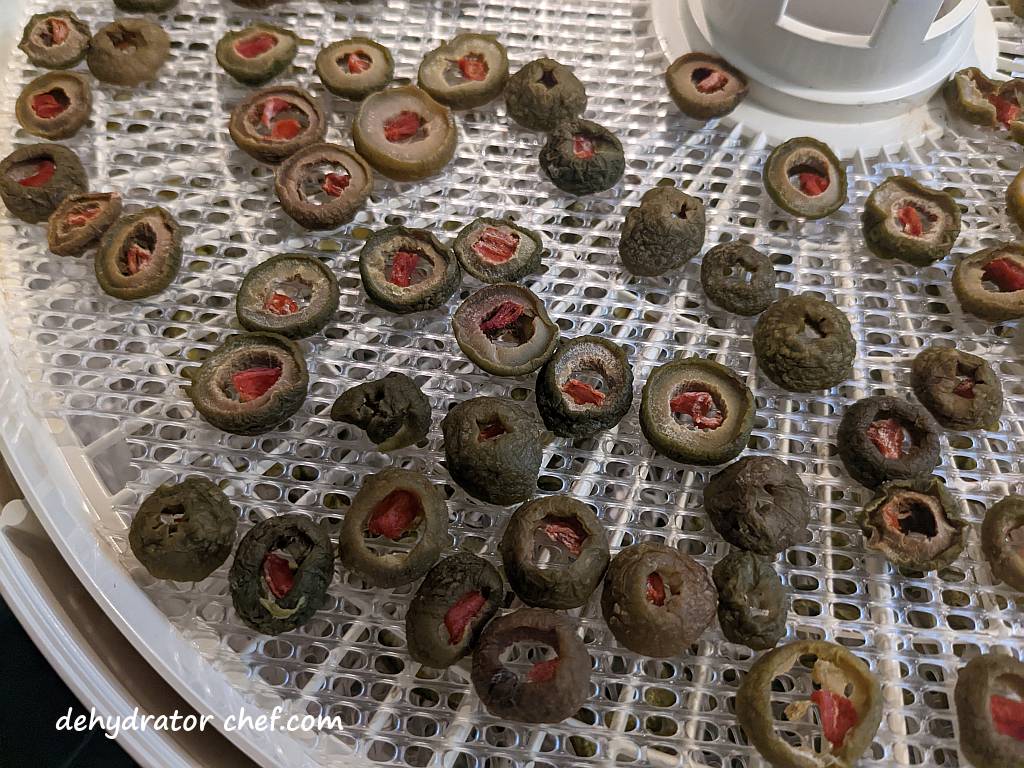
Step 5. Equalizing and Conditioning of the Dehydrated Olives
We always recommend letting food items cool completely after they have finished dehydrating and before packing them into a storage container. Warm food may cause sweating, which could provide enough moisture for mold to grow.
It does not take long for dehydrated food items to naturally start hydrating from the naturally occurring household humidity. As such, this will increase the risk of mold growth. Do not leave your dehydrated food items exposed longer than absolutely necessary.
After a short cooling period, pack the dehydrated olive rounds into clean, dry, insect-proof containers. We use pint-size mason jars to condition our dehydrated olives. Since the mason jars are clear, it’s easy to see what’s inside.
When the dehydrated olives are removed from the dehydrator, the remaining moisture may not be distributed equally among the olive rounds because of their size or their location and position in the dehydrator. Equalizing and conditioning is a process for freshly dehydrated foods that ensures any residual moisture remaining in any piece is spread or equalized among all the other pieces in the batch. Let the dehydrated olives equalize and condition in the storage container for 7 to 10 days.
Every day, check the jar for moisture. Roll the jar contents around and note any clumping or sticking. If seen, put the contents back on the dehydrator for several more hours. Since canning jars are clear, it’s easy to see what’s inside.
If you notice any mold at all, even the smallest bit, throw it out. What you see are the mold spores finally blooming enough to make them visible. But there are more, even tinier mold spores in the rest of your jar that make your dehydrated food inedible. Toss it out and start another batch.
Step 6. Storing the Dehydrated Olives
Use an appropriately sized mason jar for storage; we’re using a pint-size jar since we have quite a few of them. The dehydrated olives might keep up to 2 months. Exactly how long depends upon your pantry storage condition. But you’ll likely go through them much faster. In other words, don’t dehydrate olives for long-term storage.
We’ll use a food-safe desiccant packet for moisture control because we live in a fairly humid area. For our pint-size mason jar, we’ll use a single food-safe 5-gram desiccant packet. We’ll be raiding the jar quite frequently and we want to keep the moisture under control.
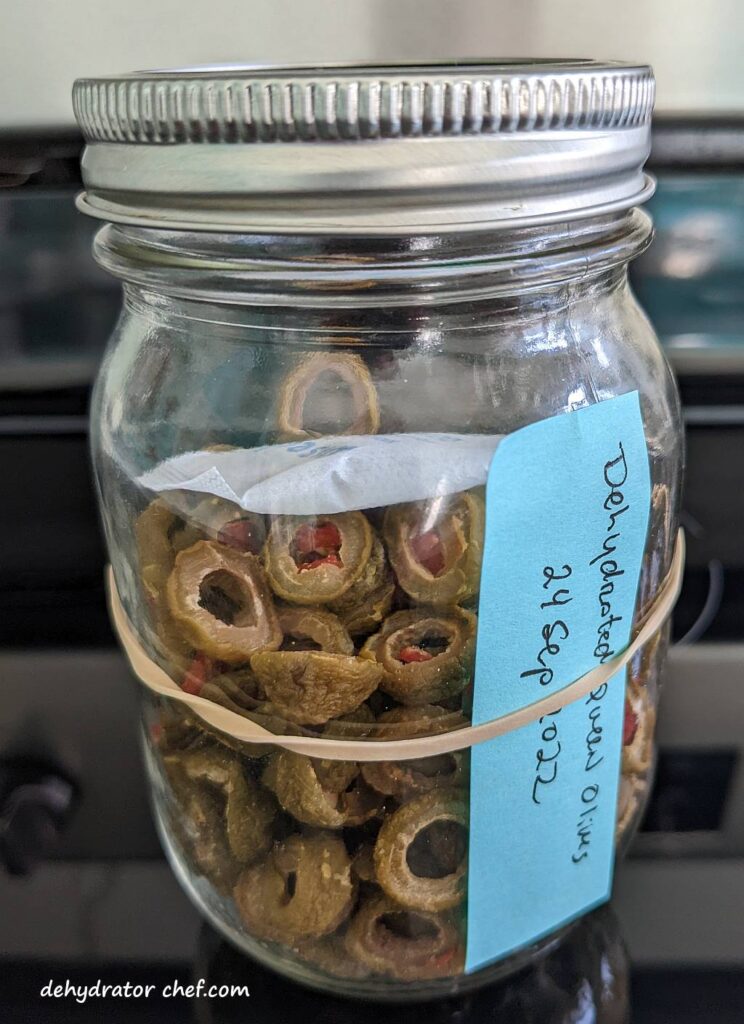
Add the desiccant packet once the 7-to-10-day conditioning period is complete.

We use these inexpensive food-safe desiccant packets, which are available from Amazon. These 5-gram packets have over 5000 of mostly 4- and 5-star customer reviews, with an average of 4.7 stars out of 5. Our bag of 60 desiccant packets will last quite a while because they can be recharged and reused multiple times. Other food-safe sizes are available.
Dehydrated food storage enemies include heat, light, moisture, oxygen, and insects or rodents.
I’ll also attach or include a short note describing the contents and the date the product was dehydrated. The note also lets me know where to go in my dehydrator logbook if I want to make another note or two.
Hydration
Dehydrated olives pieces hydrate best in a 1-to-1 ratio of olives to water. For example, 1 tablespoon of dehydrated olives pieces to 1 tablespoon of water.
We have used both cold water and hot water to hydrate. I prefer using cold water to hydrate when adding dehydrated olive pieces to cold foods such as lunchtime wraps or rolls.
If you’re supplementing store-bought freeze-dried meals as we do, just add a bit more boiling water to the pouch. Use the same 1-to-1 ratio of dehydrated olives to water.
Weights, Measures, and Serving Sizes
After a good number of dehydrating olive batches and reviewing our notes, we have seen an average of 80% of moisture loss from starting weight to dehydrated weight. We calculated these averages by weighing the jar of drained olives before processing and dehydration. Then we weighed the finished product. This is our method for figuring out the total moisture loss.
From our last round of making dehydrating olives, the olive jar food label showed the serving size was 2 olives (16 grams). Of the 48 olives in the jar, the drained contents were 271 grams and the average olive weight was 6 grams or 12 grams per serving. Just a bit off from what the jar nutrition label showed.
Dehydrated, the 2 olives now weighed 2 grams and when broken into pieces averaged about 1 tablespoon of volume. But there was a lot of air-space between the olive pieces. Was it a true tablespoon, likely not.
Insider Tips
Consider using a spice grinder to make olive powder. The olive powder makes a great spread when making wraps. This is the spice grinder we use, available on Amazon.com. It has close to 4,000 customer reviews, with an average of 4.4 stars out of 5. It comes with 2 grinding bowl, a 2-blade grinder, and a 4-blade chopper. It’s also easy to clean out the spice residue when you’re finished.
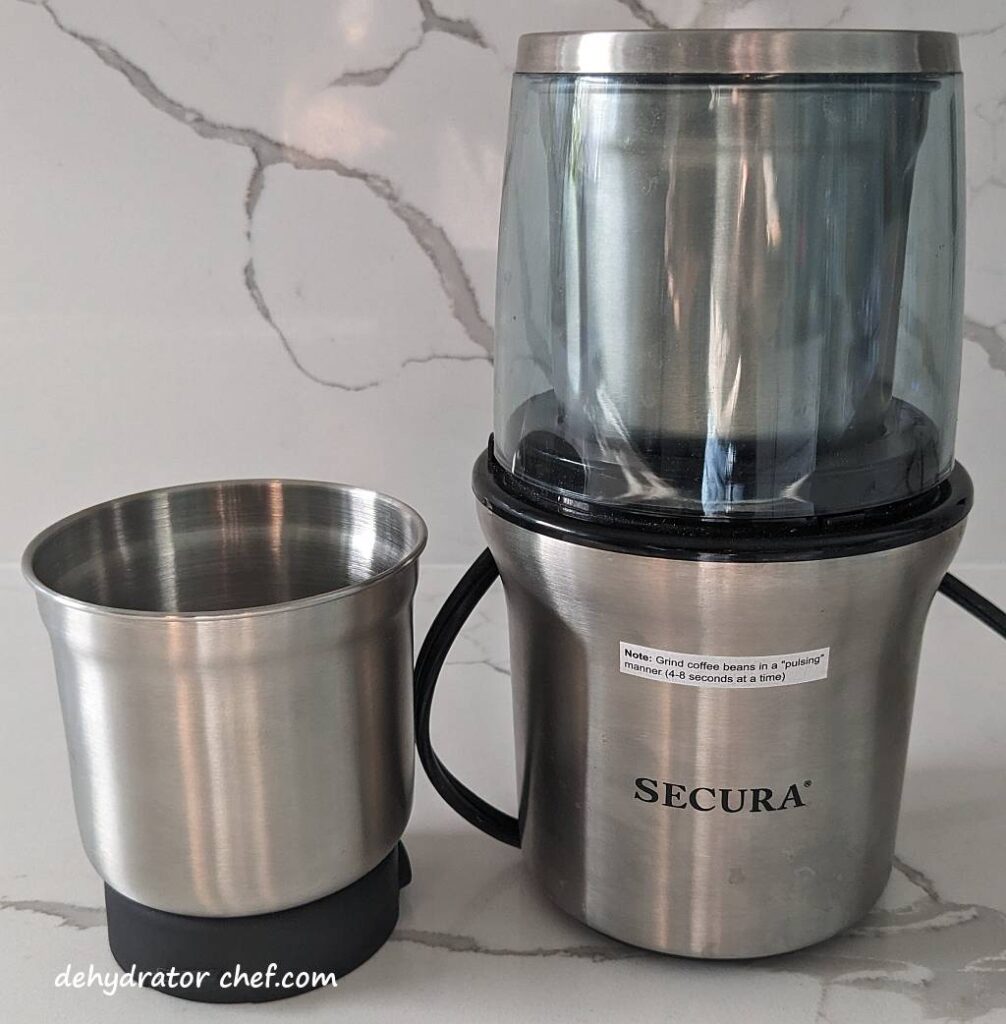
Hydrate olive powder with a 1-to-1 ratio of olive powder to water.

2 replies on “How to Dehydrate Olives – Dehydrating Olives, A Step-by-Step Guide”
Can you dry stuffed olives?
You can dehydrate pimento or jalapeno stuffed olives. But stay away from garlic, cheese, and anchovy stuffed olives. The garlic will become hard little nuggets that seemingly take forever to hydrate. Cheese won’t dehydrate. Dehydrated anchovy fish don’t last all that long.